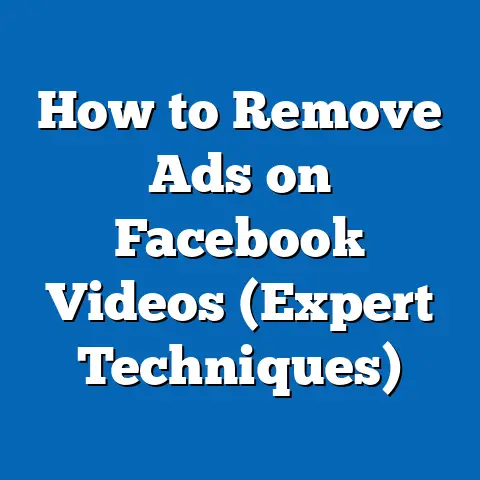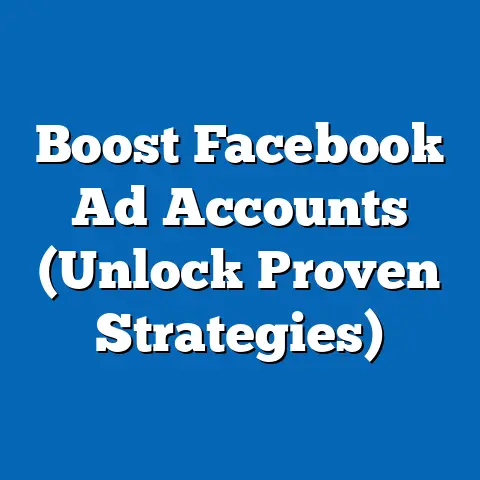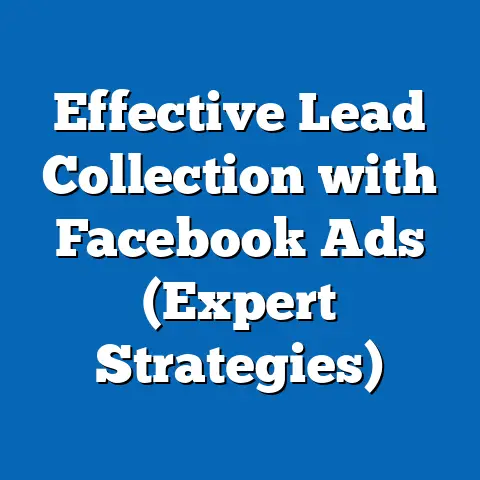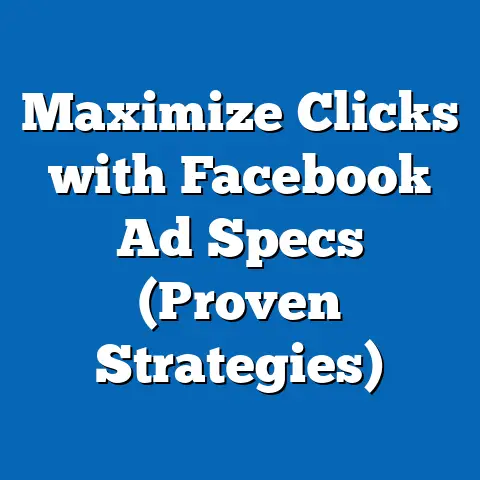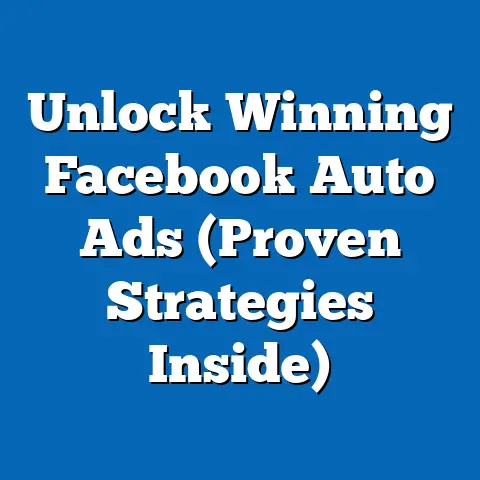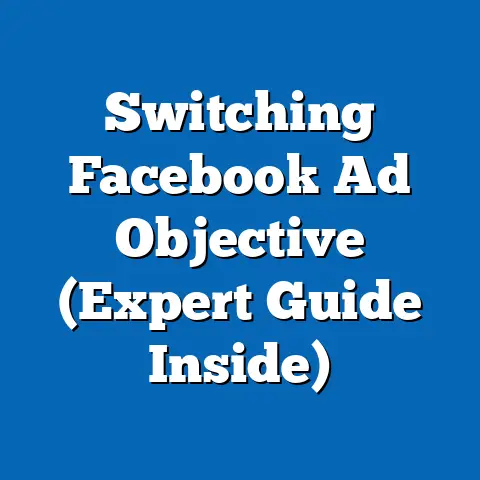Facebook Ads That Convert (Proven Strategies Revealed)
In today’s digital age, living smart extends far beyond our personal lives. It permeates every aspect of our existence, including how we conduct business and market our products or services. Smart living means making informed, strategic choices that maximize efficiency and yield the best possible results. This is especially true when it comes to digital marketing, where the landscape is constantly evolving, and competition is fierce.
Facebook, with its billions of active users, stands as a colossal platform for businesses seeking to connect with their target audiences. However, simply having a presence on Facebook isn’t enough. To truly thrive, you need to master the art of creating Facebook ads that not only capture attention but also drive conversions. This means turning those casual scrollers into paying customers.
I’ve spent years navigating the intricacies of Facebook advertising, witnessing firsthand the transformative power of well-crafted campaigns. I’ve seen businesses skyrocket their sales, generate leads, and build brand awareness, all through the strategic use of Facebook ads. I’ve also seen campaigns fizzle out due to poor targeting, uninspired creative, or a lack of understanding of the platform’s nuances.
This article is your definitive guide to crafting Facebook ads that not only attract attention but also convert leads into loyal customers, ultimately enhancing your business’s success and aligning with the principles of smart, strategic living. Let’s dive in and unlock the potential of Facebook advertising!
Section 1: Understanding Facebook Ads
Before we jump into the nitty-gritty details of crafting high-converting Facebook ads, it’s essential to have a solid understanding of what Facebook Ads are and how they function within the Facebook ecosystem. Think of Facebook Ads as your digital megaphone, allowing you to broadcast your message to a highly targeted audience on the world’s largest social media platform.
What are Facebook Ads?
Facebook Ads are paid advertisements that appear on Facebook, Instagram, Messenger, and the Audience Network. Unlike organic posts, which are only seen by your followers, Facebook Ads allow you to reach users who may not already be familiar with your brand but fit your desired customer profile.
I remember when I first started out, I thought organic reach was enough. I diligently posted content, hoping it would reach my target audience. However, I quickly realized that organic reach was declining, and I needed to invest in paid advertising to truly make an impact. That’s when I delved into the world of Facebook Ads and discovered its immense potential.
Types of Facebook Ads
Facebook offers a diverse range of ad formats to suit different marketing objectives and creative styles. Here’s a breakdown of some of the most common types:
- Image Ads: These are the simplest and most straightforward ad format, featuring a single image and accompanying text. They’re great for showcasing products, promoting events, or driving traffic to your website.
- Video Ads: Video ads are highly engaging and can be used to tell stories, demonstrate product features, or share testimonials. They’re particularly effective for capturing attention in the crowded news feed.
- Carousel Ads: Carousel ads allow you to showcase multiple images or videos within a single ad unit. Each card can have its own headline, description, and link, making them ideal for showcasing a range of products or highlighting different aspects of a service.
- Collection Ads: Collection ads are designed for mobile shoppers and feature a visually appealing layout that showcases products in a catalogue-like format. They’re great for driving product discovery and encouraging purchases.
- Lead Ads: Lead ads are specifically designed to collect leads directly on Facebook. They feature a simple form that users can fill out without leaving the platform, making it easy to capture contact information and build your email list.
The key is to choose the ad format that best aligns with your marketing goals and the type of content you want to share. I’ve found that experimenting with different formats is crucial to see what resonates best with your audience.
The Power of Audience Targeting
One of the most significant advantages of Facebook Ads is its powerful targeting capabilities. You can target users based on a wide range of criteria, including:
- Demographics: Age, gender, location, education, relationship status, and more.
- Interests: Hobbies, passions, and topics they’ve expressed interest in on Facebook.
- Behaviors: Purchase history, online activity, and device usage.
- Custom Audiences: Lists of existing customers, website visitors, or email subscribers that you can upload to Facebook.
- Lookalike Audiences: Audiences that Facebook creates based on your existing customers, website visitors, or email subscribers.
This level of granularity allows you to reach the people who are most likely to be interested in your products or services, maximizing the effectiveness of your ad spend. I once worked with a small business that was struggling to reach its target audience. By leveraging Facebook’s detailed targeting options, we were able to identify and reach a niche group of potential customers who were highly receptive to their products.
Navigating the Facebook Ads Manager
The Facebook Ads Manager is your central hub for creating, managing, and analyzing your Facebook ad campaigns. It’s a powerful tool that provides a wealth of features and insights to help you optimize your advertising efforts.
Within the Ads Manager, you can:
- Create new campaigns and ad sets.
- Choose your target audience.
- Select your ad placements (e.g., Facebook news feed, Instagram stories).
- Set your budget and bidding strategy.
- Design your ad creative.
- Track your campaign performance.
- Analyze your results and make data-driven decisions.
It can seem a bit overwhelming at first, but with a little practice, you’ll become familiar with its interface and capabilities. I recommend taking some time to explore the Ads Manager and familiarize yourself with its different sections.
Key Takeaway: Facebook Ads offer a powerful way to reach a targeted audience and achieve your marketing goals. Understanding the different ad formats, leveraging audience targeting, and mastering the Facebook Ads Manager are essential for success.
Next Steps: Take some time to explore the Facebook Ads Manager and familiarize yourself with its interface. Experiment with different ad formats and targeting options to see what works best for your business.
Section 2: Setting Up for Success
Now that you have a basic understanding of Facebook Ads, it’s time to dive into the practical steps of setting up your account and preparing for a successful campaign. Just like building a house, a solid foundation is crucial for long-term success.
Creating Your Facebook Ads Account
If you haven’t already, the first step is to create a Facebook Ads account. You’ll need a Facebook Business Page to get started. If you don’t have one, you can easily create one for free.
Once you have a Business Page, you can access the Ads Manager by clicking on “Ad Center” on your page and then selecting “All Ads.” From there, you can create a new ad account. You’ll be prompted to enter your business information, billing details, and payment method.
It’s important to ensure that your account is set up correctly and that your billing information is accurate. This will prevent any issues with your ad campaigns later on. I’ve seen accounts get suspended due to incorrect billing information, so double-check everything!
Setting Clear Goals
Before you start creating ads, it’s crucial to define your goals. What do you want to achieve with your Facebook ad campaigns? Are you looking to:
- Increase brand awareness?
- Generate leads?
- Drive traffic to your website?
- Promote a specific product or service?
- Increase sales?
Your goals will influence every aspect of your campaign, from your targeting to your ad creative to your bidding strategy. I always advise clients to start with clear, measurable, achievable, relevant, and time-bound (SMART) goals.
For example, instead of saying “I want to increase sales,” a SMART goal would be “I want to increase sales of product X by 20% in the next three months.”
Defining Your Target Audience
As I mentioned earlier, Facebook’s targeting capabilities are incredibly powerful. But to leverage them effectively, you need to have a clear understanding of your target audience. Who are you trying to reach? What are their demographics, interests, and behaviors?
Facebook’s Audience Insights tool can be a valuable resource for gathering this information. It allows you to explore the demographics, interests, and behaviors of people on Facebook, helping you to identify potential target audiences for your ads.
You can also use your existing customer data to create custom audiences. For example, you can upload a list of your email subscribers or website visitors to Facebook and target them with your ads.
I once worked with a local restaurant that was struggling to attract new customers. By using Facebook’s Audience Insights tool, we were able to identify a group of people in their area who were interested in similar cuisines and had a history of dining out. We then created ads specifically targeted to this audience, and the restaurant saw a significant increase in foot traffic.
The Importance of A/B Testing
A/B testing, also known as split testing, is a crucial part of optimizing your Facebook ad campaigns. It involves creating two or more versions of your ad with slight variations and then testing them against each other to see which one performs better.
For example, you might test different headlines, images, or calls to action to see which combination resonates best with your audience. A/B testing allows you to make data-driven decisions about your ad creative, ensuring that you’re using the most effective elements.
I always recommend that my clients run A/B tests on a regular basis. Even small changes can have a significant impact on your campaign performance.
Key Takeaway: Setting up your Facebook Ads account correctly, defining clear goals, understanding your target audience, and embracing A/B testing are essential for setting the stage for success.
Next Steps: Create your Facebook Ads account (if you haven’t already), define your SMART goals, use Audience Insights to research your target audience, and start planning your first A/B test.
Section 3: Crafting Compelling Ad Content
Now that you’ve laid the groundwork for your Facebook ad campaigns, it’s time to focus on the heart of your ads: the content. Compelling ad content is what grabs attention, sparks interest, and ultimately drives conversions. Think of your ad as a mini-sales pitch, designed to persuade your target audience to take action.
The Elements of High-Converting Ad Content
High-converting ad content typically includes the following elements:
- Headline: The first thing people see, so it needs to be attention-grabbing and relevant.
- Visual Elements (Images or Videos): High-quality visuals are essential for capturing attention and conveying your message.
- Ad Copy: The text that accompanies your visual elements, providing more information about your offer and persuading people to take action.
- Call to Action (CTA): A clear and concise instruction that tells people what you want them to do (e.g., “Shop Now,” “Learn More,” “Sign Up”).
Each of these elements plays a crucial role in the overall effectiveness of your ad. I’ve seen ads with amazing visuals fall flat because the headline was weak or the CTA was unclear.
The Psychology Behind Effective Advertising
Effective advertising taps into the emotions and desires of your target audience. People are more likely to respond to ads that resonate with their values, address their pain points, or offer them something they want.
Here are a few psychological principles to keep in mind when crafting your ad content:
- Scarcity: Create a sense of urgency by highlighting limited-time offers or limited quantities.
- Social Proof: Show that other people have had positive experiences with your products or services (e.g., testimonials, reviews).
- Authority: Position yourself as an expert in your field to build trust and credibility.
- Reciprocity: Offer something of value to your audience in exchange for their attention (e.g., a free ebook, a discount code).
I once ran a campaign for a local bakery that offered a free cookie to anyone who signed up for their email list. This offer tapped into the principle of reciprocity, and we saw a significant increase in email sign-ups.
Tips for Creating Eye-Catching Visuals and Videos
Visuals are crucial for capturing attention in the crowded news feed. Here are a few tips for creating eye-catching visuals and videos:
- Use high-quality images and videos: Avoid blurry or pixelated images.
- Choose visuals that are relevant to your offer: Make sure your visuals accurately represent your products or services.
- Use bright colors and bold designs: Stand out from the crowd with visually appealing designs.
- Keep your videos short and engaging: Aim for videos that are no longer than 15-30 seconds.
- Add text overlays to your videos: Make sure your message is clear even if people are watching your video without sound.
I often advise clients to invest in professional photography or videography to create high-quality visuals for their ads. It’s an investment that can pay off significantly in terms of increased engagement and conversions.
Examples of Successful Ad Copy and Visuals
To give you a better idea of what works, here are a few examples of successful ad copy and visuals from various industries:
- Example 1: E-commerce
- Headline: “Get 20% Off Your First Order!”
- Visual: A high-quality image of a popular product.
- Ad Copy: “Shop our latest collection and get 20% off your first order with code WELCOME20. Limited time offer!”
- CTA: “Shop Now”
- Example 2: Local Business
- Headline: “The Best Pizza in Town!”
- Visual: A mouth-watering photo of a pizza.
- Ad Copy: “Craving pizza? Come try our award-winning pizza, made with fresh ingredients and a whole lot of love. Order online or dine in!”
- CTA: “Order Now”
- Example 3: Service Provider
- Headline: “Need Help with Your Taxes?”
- Visual: A friendly image of a tax professional.
- Ad Copy: “Don’t stress about tax season. Our experienced tax professionals can help you file your taxes quickly and easily. Schedule a free consultation today!”
- CTA: “Schedule a Consultation”
- Headline: “Get 20% Off Your First Order!”
- Visual: A high-quality image of a popular product.
- Ad Copy: “Shop our latest collection and get 20% off your first order with code WELCOME20. Limited time offer!”
- CTA: “Shop Now”
- Headline: “The Best Pizza in Town!”
- Visual: A mouth-watering photo of a pizza.
- Ad Copy: “Craving pizza? Come try our award-winning pizza, made with fresh ingredients and a whole lot of love. Order online or dine in!”
- CTA: “Order Now”
- Headline: “Need Help with Your Taxes?”
- Visual: A friendly image of a tax professional.
- Ad Copy: “Don’t stress about tax season. Our experienced tax professionals can help you file your taxes quickly and easily. Schedule a free consultation today!”
- CTA: “Schedule a Consultation”
These are just a few examples, but they illustrate the key elements of effective ad content: a compelling headline, high-quality visuals, persuasive ad copy, and a clear call to action.
Key Takeaway: Compelling ad content is essential for capturing attention, engaging your audience, and driving conversions. Focus on creating high-quality visuals, writing persuasive ad copy, and including a clear call to action.
Next Steps: Review your existing ad content and identify areas for improvement. Experiment with different headlines, visuals, and calls to action to see what resonates best with your audience.
Section 4: Leveraging Facebook’s Ad Features
Facebook offers a treasure trove of ad features that can significantly enhance the performance of your campaigns. These features allow you to target your audience more precisely, optimize your ad delivery, and track your results more effectively. I consider these features the “secret sauce” of Facebook advertising.
Custom Audiences: Reaching Your Existing Customers
Custom Audiences allow you to target people who have already interacted with your business, either online or offline. You can create custom audiences based on:
- Customer Lists: Upload a list of your email subscribers or customer phone numbers to Facebook.
- Website Traffic: Target people who have visited your website or specific pages on your website.
- App Activity: Target people who have used your mobile app.
- Engagement: Target people who have engaged with your Facebook Page or Instagram profile.
Custom Audiences are incredibly valuable because they allow you to re-engage people who are already familiar with your brand. I’ve seen businesses achieve significant ROI by targeting their existing customers with special offers or promotions.
Lookalike Audiences: Expanding Your Reach
Lookalike Audiences allow you to reach new people who are similar to your existing customers. Facebook analyzes the characteristics of your custom audiences and identifies other users who share similar demographics, interests, and behaviors.
This is a great way to expand your reach and find new potential customers who are likely to be interested in your products or services. I typically recommend creating lookalike audiences based on your best customers, as they’re the most likely to convert.
Retargeting: Bringing Back Lost Opportunities
Retargeting involves showing ads to people who have previously interacted with your website or app but didn’t complete a desired action, such as making a purchase or filling out a form.
For example, you can retarget people who added items to their cart but didn’t complete the checkout process. Retargeting is a highly effective way to bring back lost opportunities and encourage people to convert.
I always advise clients to set up retargeting campaigns for their website visitors. It’s a simple way to capture leads and increase sales.
The Power of the Facebook Pixel
The Facebook Pixel is a small piece of code that you can install on your website to track user actions, such as page views, add-to-carts, and purchases. This data allows you to:
- Track Conversions: See which of your ads are driving the most conversions.
- Optimize Your Ads: Optimize your ad delivery based on conversion data.
- Create Custom Audiences: Create custom audiences based on website activity.
- Retarget Website Visitors: Retarget people who have visited your website.
The Facebook Pixel is an essential tool for any business that’s running Facebook ads. It provides valuable insights into your website traffic and allows you to optimize your campaigns for maximum ROI. I consider it a non-negotiable for any serious advertiser.
Leveraging Facebook’s Analytics Tools
Facebook provides a range of analytics tools that allow you to track the performance of your ad campaigns. These tools provide valuable insights into:
- Reach: The number of people who saw your ads.
- Impressions: The number of times your ads were displayed.
- Engagement: The number of likes, comments, and shares your ads received.
- Click-Through Rate (CTR): The percentage of people who clicked on your ads.
- Conversion Rate: The percentage of people who completed a desired action after clicking on your ads.
- Cost Per Conversion: The cost of acquiring a single conversion.
By monitoring these metrics, you can identify areas for improvement and optimize your campaigns for better results. I spend a significant amount of time analyzing Facebook Ads analytics to identify trends and patterns that can inform my advertising strategies.
Case Studies: Success with Facebook Ad Features
Here are a few case studies of businesses that have successfully used Facebook ad features to drive conversions:
- Case Study 1: E-commerce Business
- Challenge: Low conversion rates on their website.
- Solution: Implemented retargeting campaigns to target people who added items to their cart but didn’t complete the checkout process.
- Results: Increased conversion rates by 20%.
- Case Study 2: Local Restaurant
- Challenge: Struggling to attract new customers.
- Solution: Created lookalike audiences based on their existing customers and targeted them with ads promoting their menu.
- Results: Increased foot traffic by 15%.
- Case Study 3: Service Provider
- Challenge: Difficulty generating leads.
- Solution: Used lead ads to collect contact information directly on Facebook.
- Results: Increased lead generation by 25%.
- Challenge: Low conversion rates on their website.
- Solution: Implemented retargeting campaigns to target people who added items to their cart but didn’t complete the checkout process.
- Results: Increased conversion rates by 20%.
- Challenge: Struggling to attract new customers.
- Solution: Created lookalike audiences based on their existing customers and targeted them with ads promoting their menu.
- Results: Increased foot traffic by 15%.
- Challenge: Difficulty generating leads.
- Solution: Used lead ads to collect contact information directly on Facebook.
- Results: Increased lead generation by 25%.
These case studies demonstrate the power of Facebook ad features to drive conversions and achieve business goals.
Key Takeaway: Facebook offers a range of powerful ad features that can significantly enhance the performance of your campaigns. Leverage custom audiences, lookalike audiences, retargeting, the Facebook Pixel, and Facebook’s analytics tools to optimize your advertising efforts.
Next Steps: Set up the Facebook Pixel on your website, create custom audiences based on your existing customer data, and start experimenting with lookalike audiences and retargeting campaigns.
Section 5: Budgeting and Bidding Strategies
Budgeting and bidding are critical components of any successful Facebook ad campaign. Setting the right budget and choosing the right bidding strategy can significantly impact your campaign performance and ROI. It’s like finding the perfect balance between fuel and speed when driving a car.
Setting Your Budget: Daily vs. Lifetime
Facebook offers two main budget options:
- Daily Budget: The average amount you’re willing to spend each day.
- Lifetime Budget: The total amount you’re willing to spend over the entire duration of your campaign.
The best option for you will depend on your campaign goals and your level of experience with Facebook advertising. I generally recommend starting with a daily budget, as it gives you more control over your spending and allows you to make adjustments as needed.
Choosing the Right Bidding Strategy
Facebook offers a variety of bidding strategies, each designed to achieve different goals. Here are a few of the most common options:
- Cost Per Click (CPC): You pay each time someone clicks on your ad.
- Cost Per Thousand Impressions (CPM): You pay each time your ad is displayed to 1,000 people.
- Cost Per Action (CPA): You pay each time someone takes a desired action, such as making a purchase or filling out a form.
- Value Optimization: Facebook automatically optimizes your bids to maximize the value of your conversions.
The best bidding strategy for you will depend on your campaign goals and your target audience. If you’re trying to drive traffic to your website, CPC bidding might be a good option. If you’re trying to increase brand awareness, CPM bidding might be more effective. If you’re trying to drive conversions, CPA bidding or value optimization might be the best choice.
I typically recommend starting with automatic bidding and then switching to manual bidding once you have enough data to make informed decisions.
Monitoring Your Ad Spend
It’s essential to monitor your ad spend on a regular basis to ensure that you’re staying within your budget and achieving your goals. Facebook’s Ads Manager provides a wealth of data on your ad spend, including:
- Amount Spent: The total amount you’ve spent on your campaigns.
- Cost Per Result: The cost of achieving a single result (e.g., click, conversion).
- Return on Ad Spend (ROAS): The revenue you’ve generated for every dollar you’ve spent on advertising.
By monitoring these metrics, you can identify areas where you’re overspending or underperforming and make adjustments to your budget and bidding strategy as needed. I set aside time each week to review my ad spend and make any necessary adjustments.
Avoiding Common Budgeting Pitfalls
Here are a few common budgeting pitfalls to avoid:
- Setting a Budget Too Low: If your budget is too low, you may not be able to reach enough people to achieve your goals.
- Setting a Budget Too High: If your budget is too high, you may be wasting money on irrelevant clicks or impressions.
- Not Monitoring Your Ad Spend: If you don’t monitor your ad spend, you may not realize that you’re overspending or underperforming until it’s too late.
- Not Adjusting Your Budget: If you don’t adjust your budget based on your campaign performance, you may be missing out on opportunities to improve your ROI.
I’ve seen businesses make these mistakes time and time again. The key is to be proactive, monitor your ad spend, and make adjustments as needed.
Key Takeaway: Setting the right budget and choosing the right bidding strategy are crucial for maximizing your ROI. Monitor your ad spend on a regular basis and adjust your budget and bidding strategy as needed.
Next Steps: Review your existing Facebook ad campaigns and assess whether your budget and bidding strategy are aligned with your goals. Experiment with different bidding strategies to see which one performs best for your business.
Section 6: Analyzing and Optimizing Ad Performance
Analyzing and optimizing your ad performance is an ongoing process that’s essential for achieving long-term success with Facebook advertising. It’s like fine-tuning an engine to get the best possible performance.
Key Performance Indicators (KPIs) to Monitor
Here are a few of the most important KPIs to monitor:
- Click-Through Rate (CTR): The percentage of people who clicked on your ads. A high CTR indicates that your ads are relevant and engaging.
- Conversion Rate: The percentage of people who completed a desired action after clicking on your ads. A high conversion rate indicates that your landing page is effective and that your offer is compelling.
- Cost Per Conversion: The cost of acquiring a single conversion. A low cost per conversion indicates that your campaigns are efficient and that you’re getting a good return on your investment.
- Return on Ad Spend (ROAS): The revenue you’ve generated for every dollar you’ve spent on advertising. A high ROAS indicates that your campaigns are profitable and that you’re generating a significant return on your investment.
I track these KPIs religiously to identify areas where my campaigns are performing well and areas where they need improvement.
Interpreting Facebook Ads Analytics
Facebook’s Ads Manager provides a wealth of data on your ad performance. To make sense of this data, it’s important to understand how to interpret the different metrics.
For example, if your CTR is low, it could indicate that your ads are not relevant to your target audience or that your ad creative is not engaging. If your conversion rate is low, it could indicate that your landing page is not effective or that your offer is not compelling. If your cost per conversion is high, it could indicate that your targeting is too broad or that your bidding strategy is not optimal.
By analyzing these metrics, you can identify the root causes of your performance issues and make adjustments to your campaigns accordingly. I often use a spreadsheet to track my KPIs and identify trends over time.
Strategies for Ongoing Optimization
Here are a few strategies for ongoing optimization:
- Adjust Your Target Audience: Refine your targeting to reach the people who are most likely to convert.
- Refine Your Ad Content: Experiment with different headlines, images, and calls to action to see what resonates best with your audience.
- Reallocate Your Budget: Shift your budget to the campaigns that are performing best.
- Test New Bidding Strategies: Experiment with different bidding strategies to see which one delivers the best results.
- Stay Up-to-Date with Facebook’s Best Practices: Facebook is constantly evolving, so it’s important to stay up-to-date with the latest best practices.
I recommend setting aside time each week to review your ad performance and make any necessary adjustments.
Success Stories: Iterative Improvement
Here are a few success stories of businesses that have iteratively improved their Facebook ad strategies over time:
- Success Story 1: E-commerce Business
- Challenge: Low conversion rates on their website.
- Solution: Implemented a series of A/B tests to optimize their landing page and ad creative.
- Results: Increased conversion rates by 30%.
- Success Story 2: Local Restaurant
- Challenge: Struggling to attract new customers.
- Solution: Continuously refined their targeting based on their customer demographics and interests.
- Results: Increased foot traffic by 20%.
- Success Story 3: Service Provider
- Challenge: Difficulty generating leads.
- Solution: Experimented with different lead ad formats and targeting options.
- Results: Increased lead generation by 40%.
- Challenge: Low conversion rates on their website.
- Solution: Implemented a series of A/B tests to optimize their landing page and ad creative.
- Results: Increased conversion rates by 30%.
- Challenge: Struggling to attract new customers.
- Solution: Continuously refined their targeting based on their customer demographics and interests.
- Results: Increased foot traffic by 20%.
- Challenge: Difficulty generating leads.
- Solution: Experimented with different lead ad formats and targeting options.
- Results: Increased lead generation by 40%.
These success stories demonstrate the power of iterative improvement. By continuously analyzing and optimizing your ad performance, you can achieve significant results over time.
Key Takeaway: Analyzing and optimizing your ad performance is an ongoing process that’s essential for achieving long-term success with Facebook advertising. Monitor your KPIs, interpret your analytics, and implement strategies for ongoing optimization.
Next Steps: Review your existing Facebook ad campaigns and identify areas for improvement. Implement a system for tracking your KPIs and analyzing your analytics on a regular basis.
Conclusion
Throughout this guide, we’ve explored the intricacies of Facebook advertising, uncovering proven strategies that can transform your campaigns from mere impressions to powerful conversion drivers. From understanding the fundamentals to leveraging advanced features, we’ve covered the essential elements for creating Facebook ads that resonate with your target audience and deliver tangible business results.
The connection between smart living and successful Facebook advertising lies in the strategic approach. Just as smart living involves making informed choices to maximize efficiency and well-being, effective Facebook advertising requires a data-driven mindset, a willingness to experiment, and a commitment to continuous optimization.
I’ve shared my personal experiences and insights, hoping to inspire you to take a proactive approach to your Facebook advertising efforts. Remember, the key to success is not just about following the steps but also about understanding the “why” behind each strategy.
Now, armed with the knowledge and strategies shared in this article, I encourage you to take action. Start experimenting with your Facebook ad campaigns, test different approaches, and track your results. Don’t be afraid to make mistakes, as they’re valuable learning opportunities.
The world of Facebook advertising is constantly evolving, so it’s essential to stay curious, stay informed, and stay committed to continuous improvement. Embrace the challenges, celebrate the successes, and never stop learning.
So, go forth and create Facebook ads that not only capture attention but also drive conversions, ultimately enhancing your business’s success and aligning with the principles of smart, strategic living. Your journey to Facebook advertising mastery starts now!

